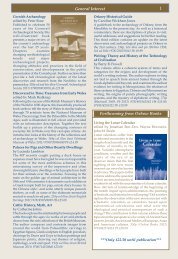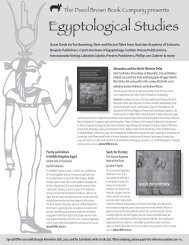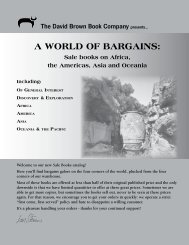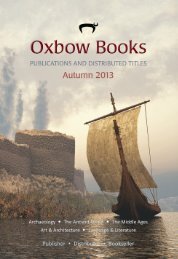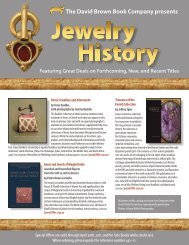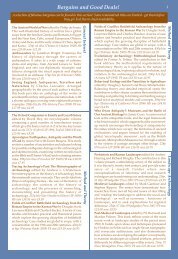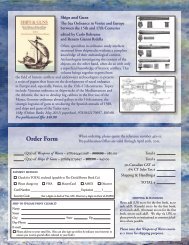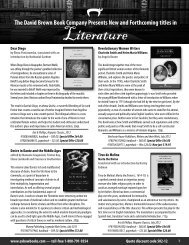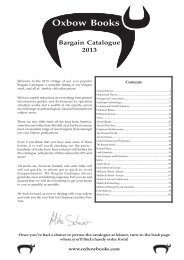MARY ROSE:YOUR NOBLEST SHIPPE
MARY ROSE:YOUR NOBLEST SHIPPE
MARY ROSE:YOUR NOBLEST SHIPPE
You also want an ePaper? Increase the reach of your titles
YUMPU automatically turns print PDFs into web optimized ePapers that Google loves.
ebates in the deck clamp reflect the positions of more<br />
beams. This enables the forward part of the deck to be<br />
reconstructed. Also, there are parts of several hanging<br />
knees to support the beams. A small portion of deck<br />
planking remains with a forward facing gun in position.<br />
Chapter 14, Propulsion by Peter Marsden and Richard<br />
Endsor, describes the considerable evidence for the<br />
ship’s propulsion to be derived from the 1514 inventory<br />
of the ship, from the image of the ship on the Anthony<br />
Roll of 1546, and from the archaeological remains. The<br />
ship had four upright masts, the fore mast, main mast,<br />
mizzen mast and bonaventure mast, and a bowsprit.The<br />
step of the main mast was found, and at the side of the<br />
ship were deadeyes for the shrouds that formerly<br />
supported that mast. Smaller deadeyes for the shrouds<br />
of the mizzen mast were also found and show where that<br />
mast was situated. No trace of the other two masts or of<br />
the bowsprit was found. Other than that there was found<br />
a mast top, a sail and a windlass. The standing and<br />
running rigging is reconstructed, with clues from pulley<br />
blocks, a parrel and other deadeyes, as well as from<br />
contemporary sources. Much more work is required on<br />
this subject.<br />
Chapter 15, Steering, mooring, anchoring and the ship’s<br />
boats by Douglas M cElvogue, discusses the limited<br />
evidence for these aspects of the ship. The incomplete<br />
ship’s rudder is described, but there was no evidence to<br />
show how the ship was steered, though a tiller was<br />
found. Several iron anchors and their wooden stocks are<br />
described, and also the coils of mooring cables found in<br />
various parts of the ship. Wooden fenders or mooring<br />
buoys were also found. The ship’s boats are referred to<br />
based on the documentary records, but their only trace<br />
was one oar.<br />
Chapter 16, Removing water by Douglas M cElvogue,<br />
describes the important evidence for removing water.<br />
The main pump-well lay beside the step for the main<br />
mast, and a second well appears to have existed further<br />
aft at an early stage in the history of the ship. A spare<br />
pump tube 8.22m long was found with its valve fittings.<br />
Two drainage dales existed on the Upper deck. The<br />
scuppers were found on the Main deck amidships, with<br />
leather sleeves that were used as valves.<br />
Chapter 17, The fighting ship by Alexzandra Hildred,<br />
describes the considerable evidence for the Mary Rose as<br />
a warship. Inventories of her weapons from 1514 to<br />
1546 are important, and link up with the discovered<br />
remains of guns, bows and arrows, and pikes and bills.<br />
There is clear evidence that when first built she mainly<br />
had anti-personnel guns, but by 1545 she had more and<br />
heavier guns. Battle tactics at sea are discussed, and the<br />
likely movement of ships in the final battle. Explanations<br />
of why the ship sank, either by rashness or negligence,<br />
are considered, and it seems that various difficulties<br />
combined to bring about the disaster of 1545 (Chap.<br />
21). A comparison is made between the ship’s guns<br />
listed in 1545–6, and those actually found and where<br />
they were positioned, as well as the handguns,<br />
gunpowder and shot. The role of the hand weapons is<br />
xxi<br />
discussed, as is the purpose of the grapnel hanging from<br />
the bowsprit.<br />
Chapter 18, Navigating the Mary Rose by Robert D.<br />
Hicks, considers the voyage in which she was sunk and<br />
the place of the navigational equipment found in her.<br />
The compasses, sandglasses, sounding leads, dividers,<br />
log reel, probable chart storage items, and a slate<br />
protractor form the earliest dated assemblage of<br />
navigational tools found in Europe. Whereas some<br />
reflect coastal voyaging, others reflect navigation based<br />
upon mathematics and an understanding of astronomy<br />
and cartography. The Mary Rose was lost at a pivotable<br />
time in the development of navigation.<br />
Chapter 19, Construction and refits: tree-ring dating the<br />
Mary Rose by Christopher Dobbs and Martin Bridge,<br />
describes the tree-ring dating of some of the ship’s oak<br />
timbers. 108 timbers were sampled, of which 41 gave<br />
dates. These showed that many timbers, such as some<br />
riders and diagonal braces, and the stern transom knees,<br />
had been added after the ship was built, and that the<br />
vessel had been rebuilt, probably in the 1530s. Other<br />
timbers were from the ship’s original construction,<br />
including three of the main deck beams, and possibly<br />
some of the overlapping planks in the Sterncastle. One<br />
frame at the waterline shows that the ship was being<br />
repaired as late as the 1540s. The tree-rings suggest that<br />
the original timbers may have been from central<br />
southern England, and that the repair timbers were<br />
perhaps from the Medway region in Kent.<br />
Chapter 20, Reconstruction of the Mary Rose: her design<br />
and use by Peter Marsden, brings together the evidence<br />
for what the ship was like in 1545 and what she may have<br />
been like when launched in 1511. The only<br />
contemporary picture of the ship is of her in 1545, in the<br />
Anthony Roll, which shows that she was a carrack.<br />
Images of other carracks around 1500 indicate that<br />
Mary Rose probably had a sharp stern below the<br />
waterline, and that later she was rebuilt with a flat<br />
transom stern. This view is also suggested by the treering<br />
dates of the knee timbers that support the transom.<br />
When originally built she had four masts and a bowsprit,<br />
and appears to have had the same decks as existed in<br />
1545, though they did not have fixed names. In an<br />
inventory of the ship in 1514 she had 78 guns, most of<br />
which were anti-personnel weapons for close combat.<br />
When she was rebuilt, probably around 1535–6, heavy<br />
guns were placed on her Main deck with new gunports<br />
cut in her sides. The gunport lids were probably opened<br />
by men manipulating ropes from the Upper deck. By<br />
1545 she had about 65 anti-personnel guns and 26 antiship<br />
guns. This extra weight of guns, and the proximity<br />
of the Main deck gunports to the waterline was a<br />
dangerous situation. Access around the ship is poorly<br />
understood, for although there were some fixed<br />
companionways, most access was apparently by movable<br />
ladders through the central hatches of the decks. When<br />
she sank there were clusters of men, represented by<br />
‘fairly complete skeletons’, in the galley, in the main<br />
storage area of the Hold, in the archery store on the




